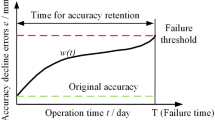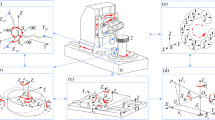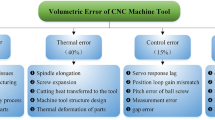Abstract
Accuracy retention is an important performance index of CNC machine tools. At present, research on the evaluation of machining accuracy retention of CNC machine tools mainly focuses on accuracy value of a fixed time point or different time periods, but studies on the fluctuation degree of degradation trajectory related to time change are limited. Extracting simple and effective degradation characteristics of machining accuracy and then evaluating machining accuracy retention considering fluctuation of degradation trajectory are necessary. The volume error model of CNC machine tools is established on the basis of multibody system theory in this study. Three-dimensional volume error vector is transformed into one-dimensional machining accuracy degradation by calculating offset distance between spatial error and origin points. Degradation data obtained via regular measurement and calculation are used to establish the complete degradation trajectory model of the CNC machine tools machining accuracy using radial basis function interpolation method according to the fluctuation degree of degradation trajectory, and concepts of average degradation rate and average degradation amount are defined. Lastly, examples showed that these two indicators can intuitively reflect fluctuation degree of machining accuracy degradation of CNC machine tools and effectively and quantitatively evaluate accuracy retention of CNC machine tools. The quantitative evaluation method of accuracy retention of CNC machine tools defined in this study considers the fluctuation degree of accuracy degradation trajectory. The quantitative evaluation index of accuracy retention demonstrates satisfactory engineering application because it can reflect not only the accuracy change of a single machine tool but also accurately compare the accuracy retention between different machine tools.
Similar content being viewed by others
Abbreviations
- δ x(x):
-
X-axis positioning accuracy error
- δ x(y):
-
Straightness error of X axis in Y direction
- δ x(z):
-
Straightness error of X axis in Z direction
- ε x(x):
-
X-axis roll angle
- ε x(y):
-
X-axis pitch angle
- ε x(z):
-
X-axis yaw angle
- L i(j):
-
I-order low-order body of body j.
- T ijP :
-
Static characteristic matrix between the two adjacent bodies of ij
- T ijS :
-
Motion characteristic matrix between the two adjacent bodies of ij
- P wideal :
-
Ideal forming function of tool
- P w :
-
Actual forming function of tools
- E :
-
Comprehensive volume error of the machine tool
- ΔE :
-
One-dimensional degradation of machine tool machining accuracy
- D m :
-
Average degradation rate
- φ m :
-
Average degradation amount
References
H. Z. Huang, Z. Liu, J. H. Mi and Y. F. Li, Reliability modeling and analysis of heavy-duty CNC machine tool spindle under hybrid uncertainty, Scientia Sinica: Physica, Mechanica et Astronomica, 48(1) (2018) 014603.
C. Qiang et al., A method to analyze the machining accuracy reliability sensitivity of machine tools based on fast Markov chain simulation, Eksploatacja i Niezawodnosc — Maintenance and Reliability, 18(4) (2016) 552–564.
C. Deng, Z. Tao, J. Wu, Y. Qian and S. Xia, Residual life prediction for NC machine tool based on performance degradation, Ji Xie Gong Cheng Xue Bao., 54(17) (2018) 181–189.
Y. Li, M. Zhao and S. Zhou, Servo axis incipient degradation assessment of CNC machine tools using the built-in encoder, International Journal of Advanced Manufacturing Technology, 106(9–10) (2020) 4293–4305.
X. Dong and W. Zhang, Degradation analysis of grinding machine spindle systems based on complexity, Proceedings of the Institution of Mechanical Engineers, Part B, Journal of Engineering Manufacture, 229(8) (2015) 1467–1471.
J. Guo, Y. Li, B. Zheng and H. Huang, Bayesian degradation assessment of CNC machine tools considering unit non-homogeneity, Journal of Mechanical Science and Technology, 32(6) (2018) 2479–2485.
Y. Cheng, H. Zhu, K. Hu, J. Wu, X. Shao and Y. Wang, Multisensory data-driven health degradation monitoring of machining tools by generalized multiclass support vector machine, IEEE Access, 7 (2019) 47102–47113.
A. C. Okafor and Y. M. Ertekin, Derivation of machine tool error models and error compensation procedure for three axes vertical machining center using rigid body kinematics, International Journal of Machine Tools and Manufacture, 40(8) (2000) 1199–1213.
B. Zhou, S. Wang, C. Fang, S. Sun and H. Dai, Geometric error modeling and compensation for five-axis CNC gear profile grinding machine tools, International Journal of Advanced Manufacturing Technology, 92(5) (2017) 2639–2652.
N. Chu and W. Zhang, Error compensation model of CNC machine-tool based on tensor theory, Transactions of the Chinese Society for Agricultural Machinery, 48(10) (2017) 408–416.
G. Zhong, C. Wang, S. Yang, E. Zheng and Y. Ge, Position geometric error modeling, identification and compensation for large 5-axis machining center prototype, International Journal of Machine Tools and Manufacture, 89 (2015) 142–150.
Y. Liu, Q. Zhang, X. Zhao, Z. Zhang and Y. Zhang, Multi-body system-based technique for compensating thermal errors in machining centers, Ji Xie Gong Cheng Xue Bao, 38(1) (2002) 127–130.
B. Yang, G. Zhang, Y. Ran and H. Yu, Kinematic modeling and machining precision analysis of multi-axis CNC machine tools based on screw theory, Mechanism and Machine Theory, 140 (2019) 538–552.
J. Zhao, L. Yuan and Q. Li, Research on error synthetical modeling of multi-functional composite five-axis CNC machine tool, IEEE International Conference on Mechatronics and Automation (2016).
M. Vahebi and B. Arezoo, Accuracy improvement of volumetric error modeling in CNC machine tools, International Journal of Advanced Manufacturing Technology, 95(5) (2018) 2243–2257.
M. Xu, Z. Wu, F. Gao, L. Liu and E. Song, Error modeling and accuracy optimization of rotating ultrasonic vibration assisted EDM machine tool, Journal of Mechanical Science and Technology, 34(7) (2020) 2751–2760.
Z. Zhang, Z. Liu, Q. Cheng, Y. Qi and L. Cai, An approach of comprehensive error modeling and accuracy allocation for the improvement of reliability and optimization of cost of a multi-axis NC machine tool, International Journal of Advanced Manufacturing Technology, 89(1) (2017) 561–579.
H. Wang, T. Li and X. Ding, Tolerance analysis of the volumetric error of heavy-duty machine tool based on interval uncertainty, International Journal of Advanced Manufacturing Technology, 114(7–8) (2021) 2185–2199.
S. Guo, S. Tang and D. Zhang, A recognition methodology for the key geometric errors of a multi-axis machine tool based on accuracy retentivity analysis, Complexity, 2019 (2019) 1–21.
S. Song, X. Dai, X. Li and D. Gong, Method of evaluating dynamic accuracy of five-axis machine tool based on test piece and comprehensive evaluation system, Sensors and Materials, 32(4) (2020) 1185–1207.
L. Zhong, F. Ren, L. Guo, Q. Bi and Y. Wang, Kinematics test and evaluation of tool axis direction error for five-axis machine tools, Materials Science and Engineering, 831(1) (2020) 12012.
W. He, L. Wang and L. Guan, A novel method for evaluating the validity of dynamic accuracy test pieces for five-axis machine tools, Proceedings of the Institution of Mechanical Engineers, Part C, Journal of Mechanical Engineering Science, 234(11) (2020) 2189–2210.
T. Otsuki, H. Sasahara and R. Sato, Method to evaluate speed and accuracy performance of CNC machine tools by speed-error 2-D representation, Journal of Advanced Mechanical Design, Systems, and Manufacturing, 13(1) (2019) JAMDSM0022.
S. Lukina and I. Manaenkov, Methodology of multiaxial machines formats volumetric accuracy comparative evaluation, IMATEC Web Conf., 129 (2017) 01046.
Q. Cheng, H. Zhao, Y. Zhao, B. Sun and P. Gu, Machining accuracy reliability analysis of multi-axis machine tool based on Monte Carlo simulation, Journal of Intelligent Manufacturing, 29(1) (2015) 191–209.
G. Chen, Y. Liang, Y. Sun, W. Chen and B. Wang, Volumetric error modeling and sensitivity analysis for designing a five-axis ultra-precision machine tool, International Journal of Advanced Manufacturing Technology, 68(9) (2013) 2525–2534.
S. Su, Identification method for errors of machining center based on volumetric error model, Chinese Journal of Mechanical Engineering, 38(7) (2002) 121–125.
V. Skala, RBF interpolation with CSRBF of large data sets, Procedia Computer Science, 108 (2017) 2433–2437.
S. Yang, Study on the spatial dynamic performance of five-axis NC machine tool based on radial basis function method, Journal of Mechanical Engineering, 55(9) (2019) 144.
C. Li, J. He, Y. Du, W. Xiao and Z. Wang, Archard model based machine tool wear model and finite element analysis, Ji xie Gong Cheng Xue Bao, 52(15) (2016) 106–113.
Acknowledgements
This work was supported by the National Natural Science Foundation of China [grant number 51975249]; Key Research and Development Plan of Jilin province [grant number 20190302017GX] and Program for JLU Science and Technology Innovative Research.
Author information
Authors and Affiliations
Corresponding author
Additional information
Cong Feng is currently a Doctoral Candidate at School of Mechanical and Aerospace Engineering, Jilin University, China. His research interest is area of the CNC machine tool fault prediction and health management.
Zhaojun Yang received his Ph.D. degree from Jilin Polytechnic University, China, in 1995. He is currently a Professor at School of Mechanical and Aerospace Engineering, Jilin University, China. His research interests include reliability techniques and theories of CNC equipment.
Chuanhai Chen received his Ph.D. in Mechanical Engineering from Jilin University, Changchun, China, in 2013. He is currently an Associate Professor with School of Mechanical and Aerospace Engineering, Jilin University, China. He focuses on the area of reliability modeling and fault diagnosis of machine tools.
Jinyan Guo is currently a Doctoral Candidate at School of Mechanical and Aerospace Engineering, Jilin University, China. Her research interest is area of the accelerated degradation test and its optimal design of numerical control equipment.
Hailong Tian received his Ph.D. in Mechanical Engineering from Jilin University, Changchun, China, in 2019. He is currently a Lecturer with School of Mechanical and Aerospace Engineering, Jilin University, China. He focuses on the area of reliability assessment based on oil pollution for CNC equipment.
Fanning Meng is currently a Doctoral Candidate at School of Mechanical and Aero-space Engineering, Jilin University, China. His research interest is area of the reliability of CNC machine tools.
Rights and permissions
About this article
Cite this article
Feng, C., Yang, Z., Chen, C. et al. Quantitative evaluation method for machining accuracy retention of CNC machine tools considering degenerate trajectory fluctuation. J Mech Sci Technol 36, 3119–3129 (2022). https://doi.org/10.1007/s12206-022-0543-6
Received:
Revised:
Accepted:
Published:
Issue Date:
DOI: https://doi.org/10.1007/s12206-022-0543-6




